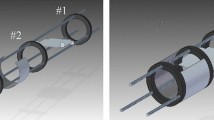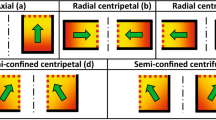Abstract
Experiments were performed to study detonation propagation in a round tube equipped with repeating orifice plates, equally spaced at two tube diameters. Tests were performed with stoichiometric hydrogen–oxygen over a range of initial pressures up to 60 kPa absolute. The self-luminous high-speed video was used to visualize the detonation for two sizes of orifice plate, i.e., 50 and 75% cross-sectional area blockage. The high-speed videos were used to obtain the average combustion wave velocity, from which the detonation propagation regime was determined, and the propagation mechanism for each orifice plate geometry was identified. For the 50% blockage ratio orifice plate tests, the detonation limit was measured to be 6 kPa, and detonation propagation was characterized by cycles of detonation failure and re-initiation after each orifice plate, resulting in a CJ detonation velocity deficit of the order of 20%. The high-speed video, captured at an oblique camera angle, showed that the detonation wave forms at hot spot(s) on the tube wall just downstream from the orifice plate, following shock reflection. For the 75% blockage orifice plates, the detonation propagation limit was measured to be 20 kPa. For initial pressures between 20 and 40 kPa, a galloping detonation mode was observed, which was not observed in a previous study performed in the same tube and orifice plates but with one-tube-diameter orifice plate spacing. The galloping mode consists of repeating cycles of fast-flame propagation between successive obstacles, followed by detonation wave propagation between the following pair of orifice plates. The experimental results were used to explain why the well-established requirement that the orifice accommodates one cell for detonation propagation (i.e., \(d/\lambda >1\)) is sufficient for low blockage ratio orifice plates; however, for high blockage ratio plates it is necessary but not sufficient.












Similar content being viewed by others
References
Ciccarelli, G., Dorofeev, S.: Flame acceleration and transition to detonation in ducts. Prog. Energy Combust. Sci. 34, 499–550 (2008). https://doi.org/10.1016/j.pecs.2007.11.002
Dorofeev, S.B.: Flame acceleration and explosion safety applications. Proc. Combust. Inst. 33, 2161–2175 (2011). https://doi.org/10.1016/j.proci.2010.09.008
Roy, G.D., Frolov, S.M., Borisov, A.A., Netzer, D.W.: Pulse detonation propulsion: challenges, current status, and future perspective. Prog. Energy Combust. Sci. 30, 545–672 (2004). https://doi.org/10.1016/j.pecs.2004.05.001
Lee, J.H., Knystautas, R., Freiman, A.: High speed turbulent deflagrations and transition to detonation in H\(_2\)–air mixtures. Combust. Flame 56, 227–239 (1984). https://doi.org/10.1016/0010-2180(84)90039-7
Peraldi, O., Knystautas, R., Lee, J.H.: Criteria for transition to detonation in tubes. Symp. (Int.) Combust. 21, 1629–1637 (1988). https://doi.org/10.1016/S0082-0784(88)80396-5
Kuznetsov, M., Alekseev, V., Bezmelnitsyn, A., Breitung, W., Dorofeev, S.B., Matsukov, I., Veser, A., Yankin, Y.: Effect of Obstacle Geometry on Behaviour of Turbulent Flames. Institut für Kern- und Energietechnik, Karlsruhe (1999)
Cross, M., Ciccarelli, G.: Influence of blockage ratio on DDT and detonation propagation limits. In: International Colloquium on the Dynamics of Explosion and Reactive Systems, Paper 243, Leeds (2015)
Gu, L.S., Knystautas, R., Lee, J.H.: Influence of obstacle spacing on the propagation of quasi-detonation. AIAA Prog. Astronaut. Aeronaut. 104, 230–247 (1988). https://doi.org/10.2514/5.9781600865886.0232.0247
Ciccarelli, G., Wang, Z., Lu, J., Cross, M.: Effect of obstacle spacing on detonation propagation. J. Loss Prev. Process Ind. 49, 739–744 (2017). https://doi.org/10.1016/j.jlp.2017.03.014
Urtiew, P.A., Oppenheim, A.K.: Experimental observation of the transition to detonation in an explosive gas. Proc. R. Soc. A 295, 1328 (1966). https://doi.org/10.1098/rspa.1966.0223
Teodorczyk, A., Lee, J.H., Knystautas, R.: Propagation mechanism of quasi-detonations. Symp. (Int.) Combust. 22, 1723–1731 (1989). https://doi.org/10.1016/S0082-0784(89)80185-7
Kellenberger, M., Ciccarelli, G.: Propagation mechanisms of supersonic combustion waves. Proc. Combust. Inst. 35, 2109–2116 (2015). https://doi.org/10.1016/j.proci.2014.08.002
Boeck, L.R., Berger, F.M., Hasslberger, J., Sattelmayer, T.: Detonation propagation in hydrogen–air mixtures with transverse concentration gradients. Shock Waves 26, 181–192 (2016). https://doi.org/10.1007/s00193-015-0598-8
Kellenberger, M., Ciccarelli, G.: Single-head detonation propagation in a partially obstructed square channel. In: International Colloquium on the Dynamics of Explosion and Reactive Systems, Paper 1135, Boston (2017)
Cross, M., Ciccarelli, G.: On the propagation mechanism of a detonation wave in a round tube with orifice plates. Shock Waves 26, 587–597 (2016). https://doi.org/10.1007/s00193-016-0676-6
Lee, J.H.S., Knystautas, R., Yoshikawa, N.: Photochemical initiation and gaseous detonations. Acta Astronaut. 5, 971 (1978). https://doi.org/10.1016/0094-5765(78)90003-6
Rainsford, G., Ciccarelli, G.: Visualization of detonation propagation in a round tube equipped with orifice plates. In: International Colloquium on the Dynamics of Explosion and Reactive Systems, Paper 1091, Boston (2017)
Dorofeev, S.B., Sidorov, V.P., Kuznetsov, M.S., Matsukov, I.D., Alekseev, V.I.: Effect of scale on the onset of detonations. Shock Waves 10, 137–149 (2000). https://doi.org/10.1007/s001930050187
Kellenberger, M., Ciccarelli, G.: Advancements on the propagation mechanism of a detonation wave in an obstructed channel. Combust. Flame 191, 195–209 (2018). https://doi.org/10.1016/j.combustflame.2017.12.023
Ciccarelli, G., Johansen, C., Kellenberger, M.: High-speed flames and DDT in very rough-walled channels. Combust. Flame 160, 204–211 (2013). https://doi.org/10.1016/j.combustflame.2012.08.009
Acknowledgements
The study was supported by the Natural Science and Engineering Research Council of Canada. Quan Li spent one year at Queen’s University doing research for his PhD, his stay was supported by a National Natural Science Foundation of China Ph.D. scholarship.
Author information
Authors and Affiliations
Corresponding author
Additional information
Communicated by L. Bauwens.
Publisher's Note
Springer Nature remains neutral with regard to jurisdictional claims in published maps and institutional affiliations.
Rights and permissions
About this article
Cite this article
Ciccarelli, G., Li, Q. & Metrow, C. The three-dimensional structure of a detonation wave propagating in a round tube with orifice plates. Shock Waves 28, 1019–1030 (2018). https://doi.org/10.1007/s00193-018-0839-8
Received:
Revised:
Accepted:
Published:
Issue Date:
DOI: https://doi.org/10.1007/s00193-018-0839-8




